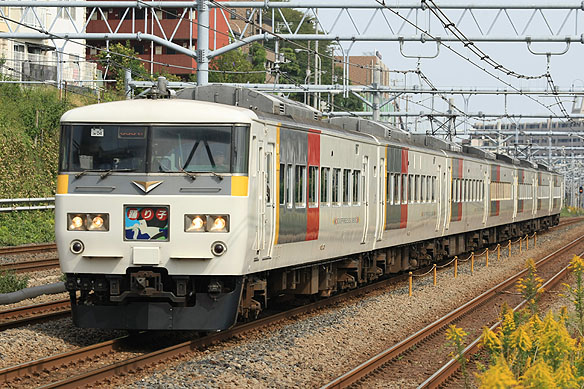Background and overview
In 1981, Japanese National Railways (JNR) developed 185-200 series DC electric
multiple unit (EMU) developed from 185-0 series EMU, replacing the superannuated
165 series currently used on "Yukemuri", "Kusatsu",
"Akagi", and "Nasuno" express services. They were also
delivered for "Shinkansen Relay" shuttle services linking Ueno
and Omiya for the start of the operations on the Tohoku Shinkansen between
Omiya and Morioka. They differ from 185-0 series in running coupled with
165 series and having the protection against snow and coldness, and the
mechanism of cooperative operation over the Usui Pass between Yokokawa
and Karuizawa in conjunction with JNR Class EF63 electric locomotives.
Their unit consists of 7 cars including one 1sr class cars. Their livery
is different from 185-0 series in having the single green waistline band
running the length of each car below the windows.
Car body and ancillary equipments
185-200 series differ from earlier 185-0 series in having a miniature snowplough,
improved diamond shaped current collector with spring covers, PS16J, and
improved thermal insulation performance body. The air conditioner of standard
class vehicles built from 1981 was changed into AU75G rated at 42,000kcal/h.
Their accommodation is same as that of 185-0 series.
Modification and refurbishment
Refurbishment programme commenced from 1995 involved replacing the original switchable transverse seating in standard-class cars with rotating/reclining seating, R55H. Externally, the sets were repainted in white with yellow/grey/red blocks intended to represent the Johmoh mountain range together with "EXPRESS 185" logos below the windows.
Operations
185-200 series were entered revenue service of "Shinkansen Relay"
shuttle services. After the operations on the Tohoku Shinkansen extended
to Ueno in Tokyo, some surplus sets were transferred for use on "Odoriko"
intercity services. Remaining sets of 185-500 series entered "Tanigawa",
"Kusatsu", "Akagi", and "Nasuno" intercity
services. They are now used on the "Akagi" and "Kusatsu"
intercity services. |
|

